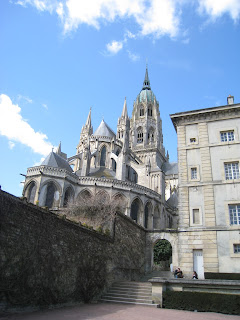Here's the somewhat nondescript building that is the home of the tapestry.
I guess we were not expecting much--there were very few people there. But boy were we blown away.
The tapestry is absolutely wonderful. It is on a very human scale, even though it tells of a great battle. There are scenes of feasts and boat-making and promise-giving. I just fell in love with it. You can't take pictures inside, but here are a few postcard scans to give you an idea of the whole tapestry.
The story essentially is that Harold, the brother-in-law of Edward the Confessor, is called by the king to go on a mission to tell William in Normandy that he will become king on Edward's death. Here you see Edward sending the compliant Harold on his mission.
On the way to see William, Harold is kidnapped and saved by William who invites the emissary to join him in battle against the king of Brittany, Conan.
William and Harold rout Conan, seen slipping down a rope to escape in this section of the tapestry. Now good friends, Harold and William celebrate and Harold vows on holy relics to support William as the new king.
But when Harold returns to England, Edward is very ill and dies soon after. Instead of sending for William, Harold has himself installed as the new king. William hears of it and brings an army to fight for his rightful crown. The day before the battle, William and his men eat a hearty meal, blessed by William's half brother who is a monk (notice the tonsure--i.e. bald spot at top of head).
William and his men go off to battle at Hastings and defeat Harold.
Harold is killed on the battlefield with an arrow in his eye. William claims his throne and becomes king of England. This all happened in 1066 and the tapestry was made soon after. It's amazing how well it is preserved considering how badly it's been treated, even once being used as a tarp for a load of armaments. It truly is spectacular.
From the tapestry, we headed for the cathedral in Bayeux, another gorgeous church.
It reminded me quite a bit of Notre Dame with its flying buttresses and gargoyles.
Inside it's very beautiful..
But I have to admit being baffled by this pulpit.
At first I thought perhaps that it was under some kind of wrap. But it looks like it might be some kind of plaster made to look like a cloud. Who knows?
After lunch it was off to the American Cemetery near Omaha Beach, the burial site of about 9000 Americans killed in World War II. It is a gorgeous and awe-inspiring site, but a very grim one as well, thinking about all the deaths.
Mary had a friend who got us a special tour of the cemetery--and special it was, led by Geert van de Bogeart, a Belgian citizen with an American accent and an encyclopedic knowledge of the site.
Here he is in front of the wall with the names of soldiers who were never recovered. There are about 5,000 named there.
There was not a question that this fellow could not answer. He was courteous, well-versed in American politics and history and all-around wonderful.
Here is an idea of where we were in relation to the beaches.
We were right above Omaha Beach, where about 2500 Americans died storming the cliffs. There were actually 35,000 people in the landing party that day, so the percentage who died was not great, but many died over the next few weeks and also most of the deaths were in the first wave of soldiers landing, so the percentage of those brave men that died was very high.
Here is the beach itself, below the cemetery.
There is a monument at the top of the site with maps of the battles and quotes about D-Day.
It looks over the cemetery proper.
Beyond the reflecting pool are rows and rows of similar headstone in perfect order.
Most headstones have crosses but some have stars of David, designating a Jewish soldier.
Some are for remains that have never been identified.
If you cannot read it, it says, "Here rests in honored glory a comrade in arms known but to God."
Mary was asked by a friend to find a particular grave. Geert had sand from the beach that we rubbed into the headstone to get a better picture of the name.
The sand will be washed away soon by the rain.
Two sons of Theodore Roosevelt are buried here, Quentin,
and Theodore Jr., apparently depicted by Henry Fonda in the movie "The Longest Day" and the recipient of the medal of honor--thus the gold lettering and the star. He actually died of a heart attack during the war.
We had no idea this would happen but we were allowed to take part in the ceremony to lower the flag at the cemetery. Here we are after folding the flag. We did not get to keep it, but it was still very moving.
All in all, it was a spectacular day.























No comments:
Post a Comment